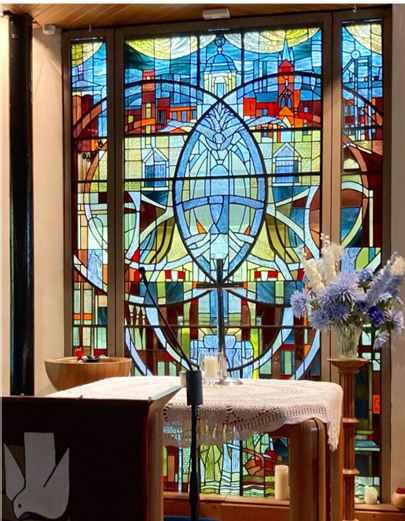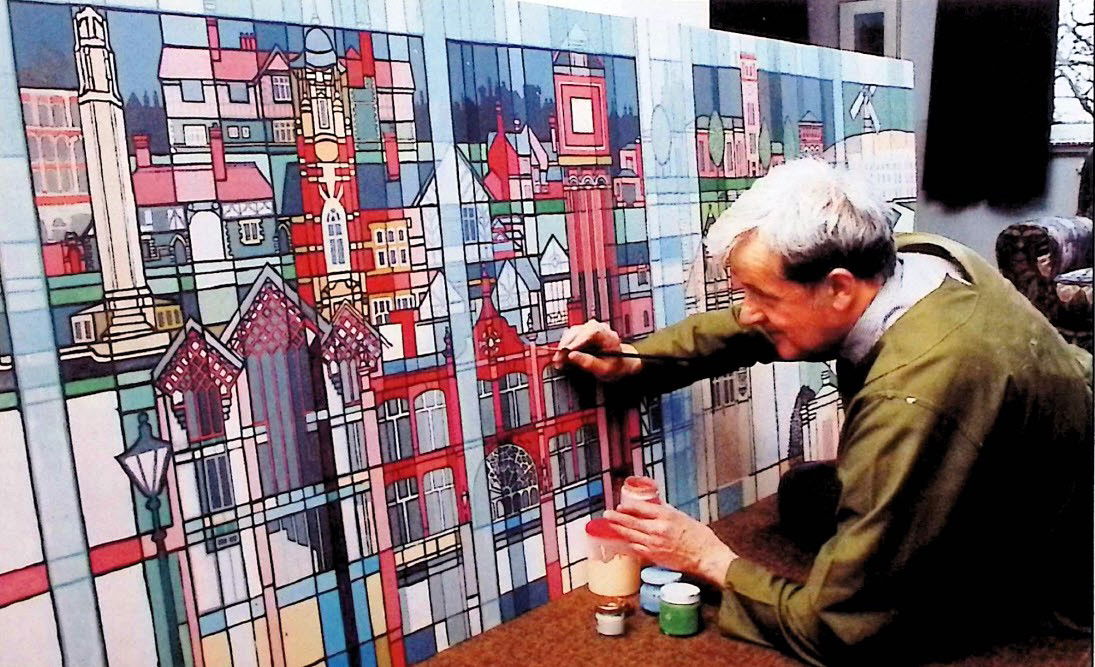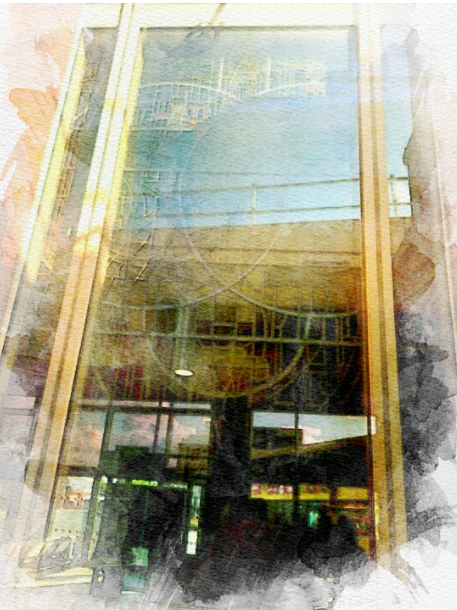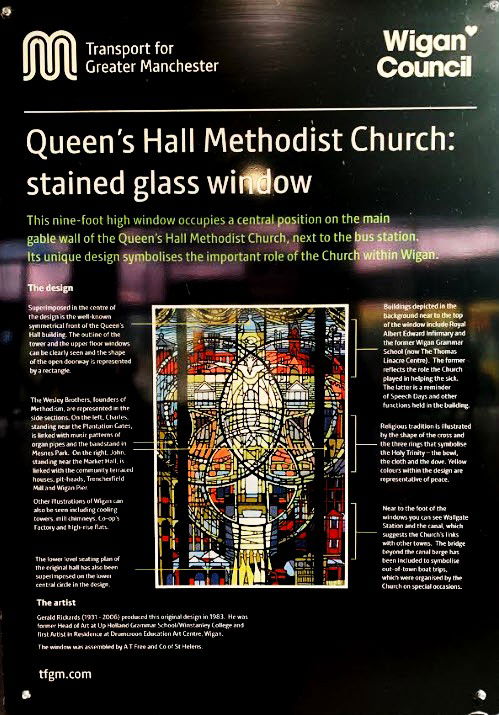Stained Glass Window

The nine-foot high stained glass window has a large central section and two narrower panels, and occupies a central position on the main gable wall of the new chapel.
It is visible from the main door and also the upper rooms in the building. The design links the role of the mission church with the town and people both past and present. Religious tradition is represented with the shape of the cross, the three rings of the Trinity, the bowl, the cloth and the dove. The shades of yellow symbolise the message of peace.

The well-known symmetrical facade of the Queen’s Hall building is superimposed in a central position. The outline of the tower and upper-floor windows can be clearly seen. A rectangle represents the shape of the open doorway, which frames the bowl and the table. The drapery-like patterns at the top of the design are based on the lead lines in the original windows in the part of the hall that has now been demolished.
The buildings depicted in the background include the Royal Albert Edward Infirmary and the old Wigan Grammar School. The former reflects the role the church plays in ministering to the sick, the latter is a reminder of speech days of the past. The seating plan of the original Queen’s Hall has also been superimposed on the lower central circle of the design. Near to the foot of the windows, images of Wallgate Station and the canal hint at links with other places. The bridge beyond the canal barge has been included to bring back memories of the boat trips which were organised on special occasions.
The Wesley brothers are represented in the side section. On the right, Charles Wesley stands near Plantation Gates and is linked with the bandstand at Mesnes Park and the pattern of organ pipes. On the left, John stands by the old Market Hall. He is linked with the community - terraced houses, pit heads, Trencherfield Mill and Wigan Pier. Cooling towers, mill chimneys, Coop’s factory and the high-rise flats can also be seen.
Gerald Rickards, a respected figure in Wigan's artistic legacy, is revered for his unique style and unwavering dedication to his craft. His artistic journey is a testament to his versatility, as he explored a wide range of mediums and techniques, from semi-abstract oils to intricate watercolours and grand murals. Rickards’ work is a fusion of precision and creativity, a true inspiration for all art enthusiasts.
Early Life and Education
Born in Aspull and later residing in Billinge near Winstanley College, Rickards' artistic inclinations were nurtured through his formal education. He attended Wigan School of Art and Liverpool College of Art, further honing his skills with a postgraduate fellowship at Edinburgh College of Art. His exceptional talent was recognized with a prize for the most distinguished work of the year, and a travelling scholarship allowed him to study mural painting across Europe. His contributions to the Diaghilev Exhibition for the Edinburgh Festival and the Sunday Observer in London also underscored his growing reputation.
Artistic Career
Rickards’ career as an artist was paralleled by his role as an educator. He served as the Head of Art at Up Holland Grammar School (later Winstanley College) for 26 years. His passion for teaching and art culminated in his position as the first Artist in Residence at Drumcroon Education Art Centre. Upon taking early retirement in 1985, Rickards dedicated himself fully to his art until his death in 2006.

Evolution of Style
Rickards’ early works from 1960 to 1975 were characterised by semi-abstract oils and linear patterns, often derived from architectural plans. These pieces sometimes incorporated religious motifs, reflecting a blend of abstract and symbolic elements.
The late 1970s marked a shift towards more recognizable subjects, with mythological creatures and birds rendered in a detailed, decorative manner against linear backgrounds. In his later years, Rickards focused on architectural elements, meticulously detailing the interplay between building facades and their backgrounds.
His approach to perspective was unconventional, frequently reimagining subjects with variations in colour and arrangement. This phase of his work highlighted his deep understanding of structure and his innovative spirit.
Exhibitions and Major Works
Rickards held over two dozen exhibitions across prominent galleries in the North West, Midlands, Cambridge, London, Salisbury, and Norwich Cathedrals. Each exhibition revolved around specific themes, such as National Trust properties, churches, cathedrals, and Oxbridge colleges, underscoring his thematic versatility and depth.
Among his large-scale works, the 37-foot Charter Mural in the History Shop, Wigan, and a floor-to-ceiling panel at Holgate School, Orrell, stand out. His murals adorned diverse locations, including the Scottish Scout Headquarters, Manchester Airport, Nantwich Post Office, and Warwickshire College. Notably, his ten-section painting for Newnham College at Cambridge and a collection featuring buildings in Salisbury's Close exemplify his large-scale artistic contributions.

Rickards also excelled in stained glass design, creating the 25-foot square Preston Guild window, and projects for Ince St Mary’s and Christ Church, Aughton. These works demonstrate his proficiency in yet another medium, adding to his multifaceted legacy.
Legacy and Influence

Gerald working on the commission for the mural to commemorate
Wigan's 750th Charter anniversary
Gerald Rickards’ work was acquired by numerous educational institutions, local authorities, British Waterways, the National Trust, Newnham College, and private collectors across Europe, America, and Australasia. His art continues to be celebrated for its distinctive style, meticulous detail, and thematic richness. Rickards’ legacy is not only preserved through his extensive body of work but also through the lasting impact he had on the artistic community and his students.

Queen's Hall Stained Glass Window
In conclusion, Gerald Rickards remains a beloved and influential figure in the world of art, particularly in Wigan. His dedication to detail, innovative approaches, and diverse body of work have left an indelible mark on the artistic landscape, inspiring future generations of artists and art enthusiasts alike.
The reverse view of the window is via the bus station, representing an unusual and unique experience.
View from the Bus Station

Bus Station view with reflections
Plaque

Plaque adjacent to the view of the stained glass window.